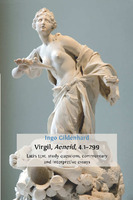Virgil, Aeneid, 4.1–299
Latin Text, Study Questions, Commentary and Interpretative Essays
| dc.contributor.author | Gildenhard, Ingo | |
| dc.date.accessioned | 2018-04-03 00:00:00 | |
| dc.date.accessioned | 2020-04-01T12:51:04Z | |
| dc.date.available | 2020-04-01T12:51:04Z | |
| dc.date.issued | 2012 | |
| dc.identifier | 646723 | |
| dc.identifier | OCN: 823771303 | en_US |
| dc.identifier.issn | 2054-2437/2054-2437 | |
| dc.identifier.uri | http://library.oapen.org/handle/20.500.12657/30302 | |
| dc.description.abstract | Love and tragedy dominate book four of Virgil’s most powerful work, building on the violent emotions invoked by the storms, battles, warring gods, and monster-plagued wanderings of the epic’s opening. Destined to be the founder of Roman culture, Aeneas, nudged by the gods, decides to leave his beloved Dido, causing her suicide in pursuit of his historical destiny. A dark plot, in which erotic passion culminates in sex, and sex leads to tragedy and death in the human realm, unfolds within the larger horizon of a supernatural sphere, dominated by power-conscious divinities. Dido is Aeneas’ most significant other, and in their encounter Virgil explores timeless themes of love and loyalty, fate and fortune, the justice of the gods, imperial ambition and its victims, and ethnic differences. This course book offers a portion of the original Latin text, study questions, a commentary, and interpretative essays. Designed to stretch and stimulate readers, Ingo Gildenhard’s incisive commentary will be of particular interest to students of Latin at both A2 and undergraduate level. It extends beyond detailed linguistic analysis to encourage critical engagement with Virgil’s poetry and discussion of the most recent scholarly thought. | |
| dc.language | English | |
| dc.relation.ispartofseries | Classics Textbooks | |
| dc.subject.classification | thema EDItEUR::4 Educational purpose qualifiers::4Z For specific national or regional educational curricula | en_US |
| dc.subject.classification | thema EDItEUR::4 Educational purpose qualifiers::4C For all educational levels::4CN For advanced / upper secondary education | en_US |
| dc.subject.classification | thema EDItEUR::C Language and Linguistics::CF Linguistics::CFP Translation and interpretation | en_US |
| dc.subject.classification | thema EDItEUR::N History and Archaeology::NH History::NHC Ancient history | en_US |
| dc.subject.other | latin | * |
| dc.subject.other | translation | * |
| dc.subject.other | classics | * |
| dc.subject.other | classics textbook series | * |
| dc.subject.other | ancient rome | * |
| dc.subject.other | sixth-form study guide | * |
| dc.subject.other | aeneid | * |
| dc.subject.other | virgil | * |
| dc.subject.other | Aeneas | * |
| dc.subject.other | Carthage | * |
| dc.subject.other | Jupiter | * |
| dc.subject.other | Venus | * |
| dc.subject.other | Textbook | * |
| dc.title | Virgil, Aeneid, 4.1–299 | |
| dc.title.alternative | Latin Text, Study Questions, Commentary and Interpretative Essays | |
| dc.type | book | |
| oapen.identifier.doi | 10.11647/OBP.0023 | |
| oapen.relation.isPublishedBy | 23117811-c361-47b4-8b76-2c9b160c9a8b | |
| oapen.relation.isbn | 9781909254152 | |
| oapen.collection | ScholarLed | |
| oapen.pages | 319 | |
| oapen.remark.public | Relevant Wikipedia pages: Aeneas - https://en.wikipedia.org/wiki/Aeneas; Aeneid - https://en.wikipedia.org/wiki/Aeneid; Carthage - https://en.wikipedia.org/wiki/Carthage; Jupiter - https://en.wikipedia.org/wiki/Jupiter; Venus - https://en.wikipedia.org/wiki/Venus; Virgil - https://en.wikipedia.org/wiki/Virgil | |
| oapen.identifier.ocn | 823771303 |

